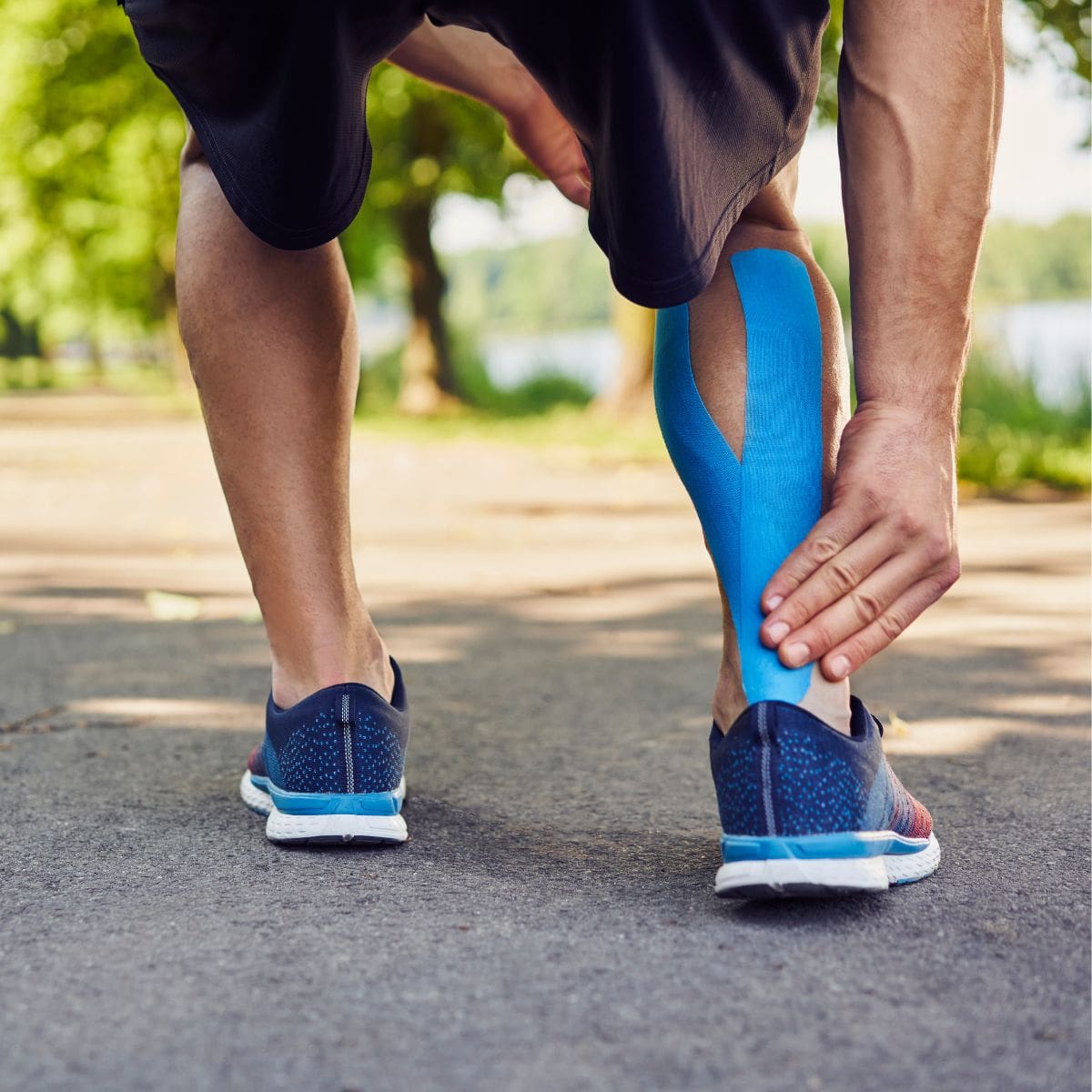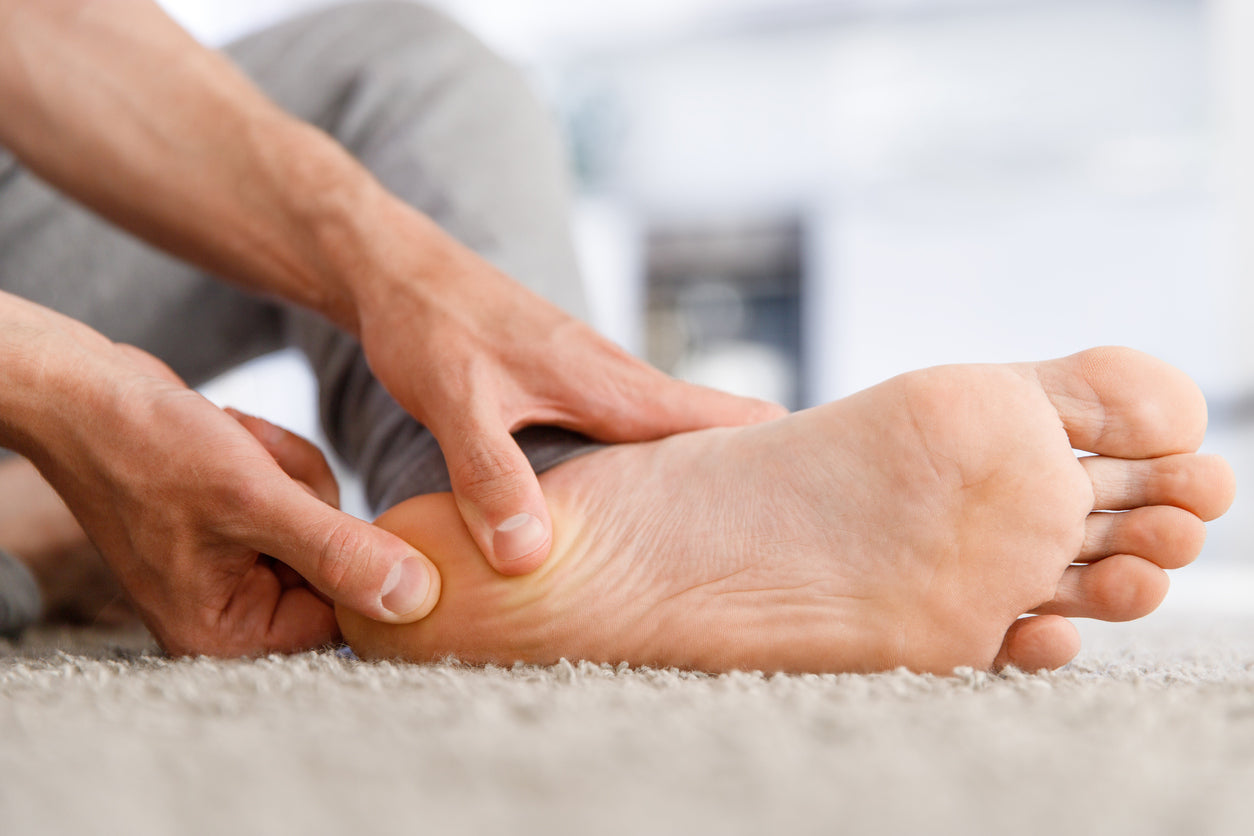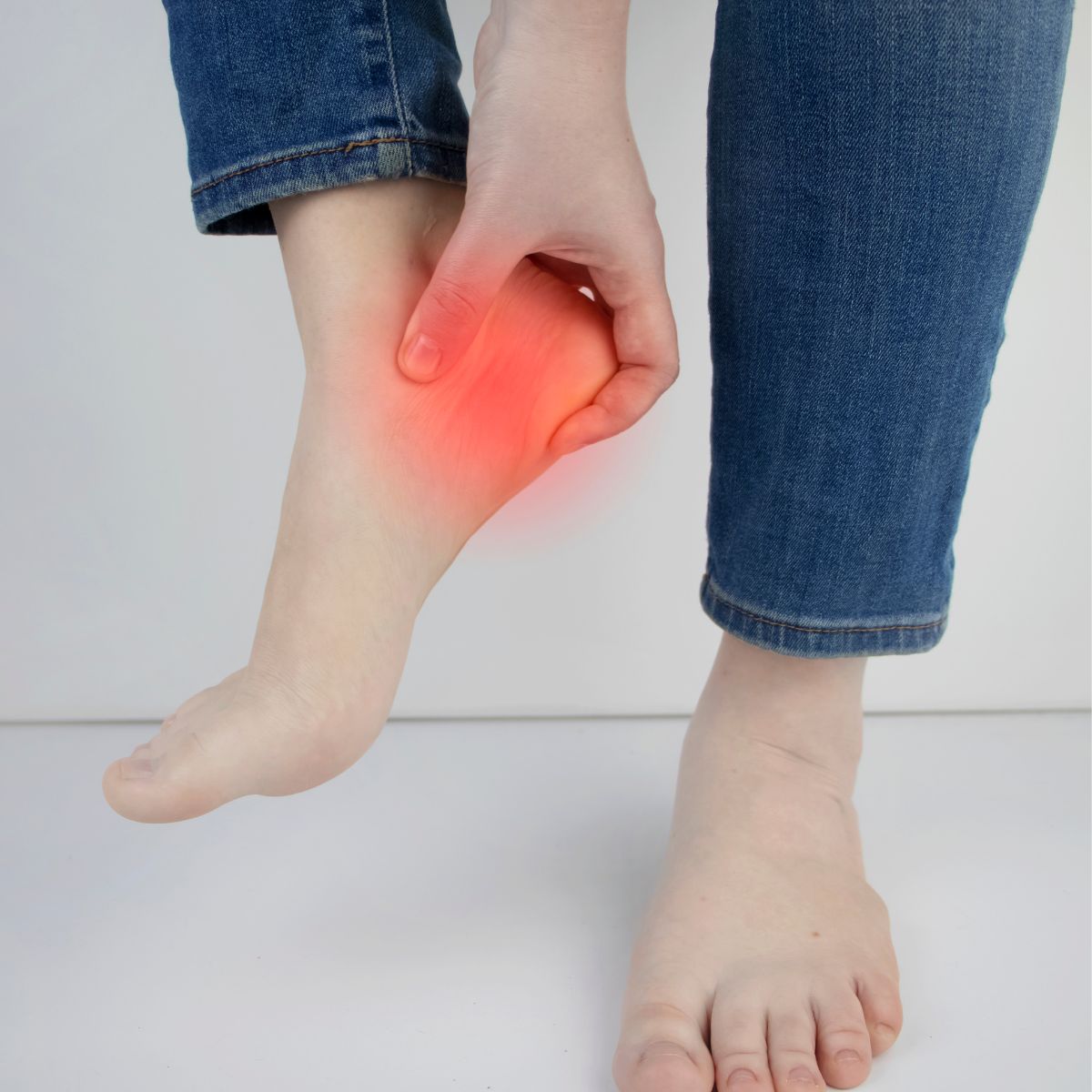Taping for Achilles tendonitis is a popular method used to alleviate pain and enhance function in the injured tendon.
Clinicians often recommend taping as it is believed to improve circulation, reduce pain, and promote healing. While the research on its effectiveness is mixed, many patients find it beneficial.
It's important to note, however, that taping alone does not expedite the recovery process or provide protection against re-injury. Other evidence-based treatments, such as massage therapy and strength training exercises, can also be effective in managing Achilles tendonitis.
Whether you're an athlete or someone leading an active lifestyle, using a tape for Achilles tendonitis can be effective way to ensure recovery.
Here's a step-by-step guide on how to get started!
Key Takeaways
- Taping for Achilles tendonitis is a common method used to relieve pain and improve function.
- Alternatives to taping, such as strength training exercises and heel lifts, can also be effective in managing Achilles tendonitis.
- Proper preparation, including stretching and warming up, is crucial before applying foot tape.
- Choosing the right type of tape and following the proper technique is important for effective taping.
How to Perform Taping for Achilles Tendonitis
When it comes to managing Achilles tendonitis, applying foot tape correctly is essential for optimal results.
Follow this step-by-step guide to properly tape your foot and provide support to the affected area:
Step 1: Apply pre-wrap or underwrap
Using pre-wrap or underwrap can provide extra protection for the skin and improve the adhesion of the tape.
Start by wrapping the pre-wrap or underwrap around the foot and ankle.
Step 2: Anchor the tape at the bottom of the foot

Start the taping process by anchoring the tape at the bottom of the foot, near the arch.
Wrap the tape around the foot once to secure it in place.
Step 3: Create support strips along the Achilles tendon
Continue taping by creating support strips along the Achilles tendon.
Apply the tape vertically, overlapping each strip by about half its width. This provides stability and support to the tendon.
Step 4: Secure the tape
Finish the taping by securing the tape at the top of the calf muscle, bottom of the foot, or across the ankle, depending on your preference and comfort.
Make sure the tape is applied firmly but not too tight, as excessive tension can restrict blood flow. It's important to pay attention to detail and avoid common mistakes while taping.
Applying too much tension or using the wrong type of tape can compromise its effectiveness.
Tips to Follow When Taping for Achilles Tendonitis
When using tape to manage Achilles tendonitis during physical activity, proper maintenance and reapplication are key to ensuring its effectiveness.
Here are some tips to help you maintain the tape and reap the benefits:
Avoid excessive moisture
Moisture can cause the tape to lose its adhesion, compromising its support and stability.
To prevent this, make sure to keep the taped area as dry as possible during physical activity.
If you anticipate excessive moisture, such as sweating or wet conditions, consider using a waterproof tape or applying a protective spray over the tape to maintain its adhesion.
Proper skin preparation

Before reapplying the tape, it is crucial to clean and prepare the skin properly.
Remove any dirt, sweat, or oils from the area by gently cleansing it with mild soap and water. Pat the skin dry with a clean towel, ensuring that it is completely dry before applying fresh tape.
Proper skin preparation promotes better adhesion and reduces the risk of the tape slipping or causing skin irritation.
Listen to your body
While tape can provide support and relief for Achilles tendonitis, it is essential to listen to your body during physical activity.
If the tape feels too tight, uncomfortable, or causes any irritation, it may need to be adjusted. Pay attention to any discomfort or changes in sensations and make the necessary adjustments to ensure your comfort and safety.
By following these tips and adopting a proactive approach to tape maintenance and reapplication, you can maximize the benefits of taping for Achilles tendonitis.
Regular replacement
Tape wears out over time, especially during physical activity that involves repetitive movements and increased stress on the Achilles tendon.
It is important to monitor the condition of the tape and replace it when necessary. Look for signs of peeling, reduced adhesion, or fraying edges.
Regularly inspecting the tape and replacing it as needed will ensure that you continue to receive the desired support and relief.
Best Taping Products for Achilles Tendonitis
When it comes to taping Achilles tendonitis, there are various types of tape that can be used to provide support and relief.
A few of them include:
Kinesiology tape

Kinesiology tape is a specialized tape that mimics the elasticity of human skin, allowing for comfortable movement while still providing support.
It is designed to promote proper blood circulation, reduce pain and inflammation, and improve proprioception.
Applied in a specific pattern, kinesiology tape can help relieve pain and improve function in individuals with Achilles tendonitis.
Rigid tape
Rigid tape, also known as athletic tape, is a strong and sturdy tape that offers excellent support and stability.
It is commonly used in sports and physical activities that require a high level of motion control. Rigid tape helps immobilize the affected area, preventing excessive movement and reducing strain on the Achilles tendon.
It provides reliable support and can be particularly beneficial for individuals with severe Achilles tendonitis or those who require additional stability during physical activity.
Elastic bandages
Elastic bandages, often made of compression material, are another option for taping Achilles tendonitis.
These bandages provide moderate support and compression to the affected area, helping to reduce swelling and improve blood circulation. Elastic bandages are adjustable and versatile, allowing for a personalized fit and the ability to change the level of compression as needed.
They can be an effective choice for individuals with mild to moderate Achilles tendonitis who prefer a more flexible taping option.
Each type of tape has its own advantages and considerations, and the most suitable tape for taping Achilles tendonitis may vary depending on factors such as the severity of the condition, individual preferences, and the type of activity being performed.
Alternatives to Taping for Achilles Tendonitis
While taping is a commonly used method for managing Achilles tendonitis, there are alternative treatments that can also be effective.
It is important to focus on pain management and the healing process to promote a faster recovery and prevent further injury.
Here are some alternatives to consider:
Leg massagers

Using a powerful leg massager like the Fusion Air C Pro can provide several benefits for individuals dealing with Achilles tendonitis.
The massager's targeted compression and kneading motions can help reduce pain and inflammation in the affected area. By applying gentle pressure to the leg muscles, it can alleviate muscle tension and promote relaxation, resulting in pain relief.
An increased blood flow also delivers oxygen and nutrients to the injured area, aiding in tissue repair.
Heel lifts
Heel lifts can help reduce strain on the Achilles tendon by raising the heel and decreasing the amount of tension placed on the tendon during movement.
These lifts can be inserted into the shoes and provide additional support and cushioning. They can alleviate pain during activity and promote proper healing.
Massage guns

Using a massage gun for Achilles tendonitis can provide significant benefits for individuals suffering from this condition.
Firstly, the percussive motions of an safe device like the Fusion elite massage gun can help reduce pain and discomfort associated with inflammation in the Achilles tendon. It can also help to improve blood circulation to the affected area, aiding in the healing process by delivering essential nutrients and oxygen to the tissues.
It can also improve flexibility and range of motion in the ankle and calf muscles, helping individuals regain mobility and perform daily activities more comfortably.
What's more, the convenience and accessibility of a massage gun allow for at-home use, providing consistent relief and the ability to incorporate regular massage sessions into the treatment plan for Achilles tendonitis
Physical therapy
Physical therapy can be an effective alternative to taping for Achilles tendonitis.
A physical therapist will design a personalized treatment plan that includes stretching, strengthening, and other therapeutic exercises to reduce pain, improve flexibility, and enhance the healing process.
They may also use modalities such as ultrasound or electrical stimulation to promote tissue repair.
Orthotic devices
Orthotic devices, such as shoe inserts or custom orthotics, can provide additional support, stability, and cushioning to the foot and ankle.
These devices help optimize the alignment of the foot and reduce excessive stress on the Achilles tendon.
Rest and anti-inflammatory measures
Rest is crucial for the healing of the Achilles tendon.
Giving it time to recover and avoiding activities that exacerbate the pain can alleviate symptoms and promote healing.
Additionally, using anti-inflammatory measures such as ice therapy, compression, and nonsteroidal anti-inflammatory drugs (NSAIDs) can help reduce swelling and pain associated with Achilles tendonitis.
Frequently Asked Questions
Get answers to most frequently asked questions we get on tapping for Achilles Tendonitis. Feel free to reach out if you have more questions!
Can taping for Achilles Tendonitis affect my range of motion?
Taping your Achilles tendonitis is commonly used to provide support and alleviate pain, but its impact on range of motion is often overlooked.
The tape's compression and support may restrict the natural movement of the ankle joint, potentially affecting the range of motion. It is important to balance the benefits of taping with the need for maintaining proper ankle mobility during activities.
What are the benefits of taping for Achilles tendonitis?
The benefits of taping for Achilles tendonitis is an intriguing area to explore.
It helps alleviate pain, supports the injured tendon, improves blood flow, enhances body awareness, and boosts confidence during physical activities.
However, taping should be combined with other treatment methods for optimal management of Achilles tendonitis.
How long should I wear a tape for Achilles tendonitis?
The duration of tape wear for Achilles tendonitis can vary depending on individual circumstances and treatment recommendations.
It is generally recommended to wear the tape during periods of physical activity or when engaging in activities that may put strain on the Achilles tendon. During these times, taping can provide support and reduce discomfort. However, it's important to allow the skin to breathe and recover between taping sessions.
Therefore, it is generally advisable to remove the tape and give the skin a break for several hours or overnight. This allows the skin to recover and prevents any potential skin irritation or adhesion issues.
Conclusion
Taping is a beneficial method for managing Achilles tendonitis and providing pain relief.
Many individuals find it effective in reducing pain and improving function. However, it is important to note that taping does not speed up the healing process or protect against re-injury.
To achieve optimal healing and prevent Achilles tendonitis, it is recommended to incorporate other evidence-based treatments, such as strength training exercises and wearing proper footwear.
Also remember, taking a proactive approach to managing Achilles tendonitis can enhance your healing process and reduce the risk of future injuries. By doing so, you can promote healing, prevent re-injury, and enjoy an active, pain-free lifestyle.




